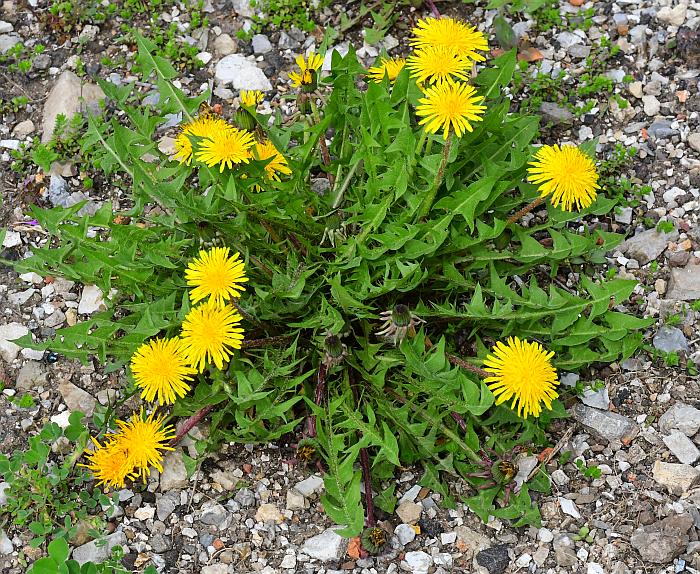Taraxacum officinale F.H. Wigg.
Common Dandelion

Introduced
CC = *
CW = 3
MOC = 81
© SRTurner
Taraxacum officinale F.H. Wigg.Common Dandelion | |
 |
Introduced CC = * CW = 3 MOC = 81 |
© SRTurner |
|
Family - Asteraceae/Cichorieae Habit - Perennial forb with a fleshy taproot.
Stem - Ascending to erect, 1 to several, to 40 cm, continuing to elongate as the heads mature, unbranched, hollow, nearly smooth, glabrous or with patches of fine, white, cobwebby hairs, sometimes purplish-tinged or purplish-mottled.
Leaves - All basal, short-to long-petiolate. Leaf blades shallowly to deeply and irregularly pinnately lobed, sometimes more shallowly lobed toward the tip than toward the base, sometimes nearly compound, narrowly oblanceolate to obovate or elliptic in outline, the lobes triangular with angled sinuses, irregularly toothed, glabrous or 1 or both surfaces sparsely to moderately pubescent along the veins with fine, irregularly curled, white, sometimes somewhat cobwebby hairs, sometimes pinkish-to purplish-tinged toward the base. Venation of 1 main vein and a network of anastomosing secondary and tertiary veins.
Inflorescences - Heads solitary at the stem tips. Heads - Ligulate. Involucre 12-25 mm long, elongating somewhat as the fruits mature, somewhat urn-shaped to cup-shaped at flowering, the inner series of bracts mostly 13-23, the outer series less than to more than half to about half as long as the inner series, usually glabrous, often purplish-tinged, especially toward the tip; those of the inner series similar in size and shape, sometimes more or less fused along the margins toward the base when young, lanceolate, with well-differentiated, thin, pale margins, the tip sharply pointed or minutely notched, ascending at flowering; those of the outer series less than to more than half as long as the inner series, ovate to narrowly ovate, mostly becoming reflexed as the heads first develop. Receptacle naked.
Florets - Ligulate florets 40-120 or more per head. Corollas bright yellow, sometimes purplish-or grayish-brown-tinged on the outer surface. Pappus of numerous bristles, these smooth or microscopically barbed, white.
Fruits - Fruits with the body 3-4 mm long, oblanceolate in outline, tapered to a slender beak usually more than twice as long as the body, not or only slightly flattened, with 4 or 5 rounded or flattened ribs, these sometimes with 1 or 2 shallow longitudinal grooves, smooth or appearing smooth or more commonly minutely pebbled or roughened, with several rows of prominent barbs toward the tip, glabrous, olive-colored to greenish brown at maturity, the pappus attached to a relatively broad, expanded, disclike tip.
Flowering - Any month of the year. Habitat - Lawns, gardens, cemeteries, fields, pastures, roadsides, railroads, open disturbed areas. Origin - Native to Europe Lookalikes - Numerous other species in the Cichorieae tribe of the Asteraceae. Other info. - There are very few people who do not know this plant, and it is included here partially as a reference for comparison to lookalike species. It can be differentiated from most other lookalikes by its laciniate leaves which are all basal, hollow stems with milky juice and a single flowering head, and outer involucral bracts which are typically reflexed. The plant occurs across Missouri, the U.S., and in temperate regions globally. Photographs taken near Labadie, Franklin County, MO, 3-27-2020, at Pacific Palisades Conservation Area, MO, 4-2-2020, along the Katy Trail near Dutzow, Warren County, MO, 4-3-2020, and along the Katy Trail near Treloar, Warren County, MO, 4-22-2022 (SRTurner). |